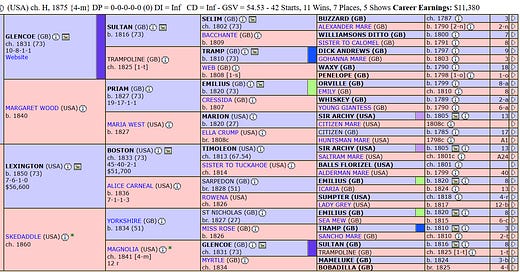Linebreeding in the Kentucky Derby: Part One
Observing inbreeding and linebreeding trends in America's most prestigious race
Over the last month or so, I’ve been digging into linebreeding trends in elite Thoroughbreds, with a particular focus on the eight-generation coefficient of inbreeding (COI) - as calculated by PedigreeQuery.com - and the duplication of distant ancestors. It has been demonstrated that while close inbreeding is negatively correlated with racing performance and soundness measures, distant inbreeding is positively correlated with racing performance. Naturally, not all inbreeding is created equal, and the efficacy of inbreeding can vary depending on the ancestor being duplicated. Curiously, a 2018 study on inbreeding in the Australian Thoroughbred population showed that greater inbreeding to Herod was positively correlated with higher career earnings, earnings per start, and career length in his modern descendants.
Curious to explore the ways breeders might optimize for distant linebreeding in their mating decisions, I decided to begin my investigation with the most prestigious race in the United States, the Kentucky Derby, and share some of my findings here. Please note that while I usually define inbreeding as an ancestor appearing on both the sire and dam’s side of the pedigree (you may notice in other posts that I will generally refer to a horse’s sire or dam being inbred if the duplicated ancestor is on only one side of the pedigree), it will be used here to refer to any time an ancestor appears multiple times in the pedigree, regardless of the position. To help clarify, I will be using “S” and “D” in my inbreeding notation to denote whether the ancestor appears on the sire or dam’s side of the pedigree.
For each Kentucky Derby winner, I noted the ancestor with the highest concentration of blood, where the inbreeding to that ancestor occurred in the pedigree, that ancestor’s percentage of influence (based on the estimation that each parent contributes 50% of the genetic material to a foal), any ancestors that appeared at least 15 times in nine generations of pedigree, along with their percentage of influence, and the eight-generation coefficient of inbreeding for the Derby winner in question. The choice to note ancestors repeated 15 times was made somewhat arbitrarily, as from prior casual observation it had seemed to me that most horses would have 10 or more copies of multiple ancestors, but generally only had a few, if any, ancestors repeated 15 times.
The results were quite intriguing, and while I’m not sure I’m any closer to my original goal of learning more about how modern breeders might improve their stock through linebreeding, I learned quite a bit about trends in how the winners of our most prestigious race are bred, which has fluctuated throughout the years. I think the most interesting way to parse this information will be to summarize my findings by decade, then discuss some possible takeaways and future studies that could help contextualize this information. With 149 years of history to cover, I am going to break this analysis down into two posts. Today, I will be discussing Derby winners through 1949, and the second half of this discussion will be releasing on Friday.
Before we get to the paywalled breakdown, though, I’d like to share a few quick bullet points that I thought would be of interest:
The average inbreeding coefficient for Kentucky Derby winners is 2.42%
Rich Strike (2022) is the most inbred Kentucky Derby winner, with a COI of 8.74%
Genuine Risk (1980) is the least inbred Kentucky Derby winner, with a COI of .44%
There are six Kentucky Derby winners with a COI of 1% or less (4% of Derby winners)
There are nine Kentucky Derby winners with a COI of 5% or higher (6% of Derby winners), and only three - Rich Strike (2022), Big Brown (2009), and Day Star (1878) - with a COI over 6% (2% of Derby winners)
Justify (2018) is the most inbred Triple Crown winner, with a COI of 3.16%
Secretariat (1973) is the least inbred Triple Crown winner, with a COI of 1.17%
Prior to 1990, only two Kentucky Derby winners - Black Gold (1924) and Omar Khayyam (1917) - did not have at least 15 crosses of at least one ancestor within nine generations (1.7%)
Since 1990, 12 Kentucky Derby winners have not had at least 15 crosses of any one ancestor within nine generations (34.3%)
Keep reading with a 7-day free trial
Subscribe to Hawkstone Bloodstock to keep reading this post and get 7 days of free access to the full post archives.



